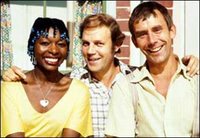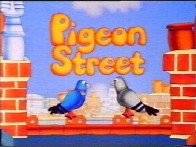Playschool

PLAYSCHOOL Made by: BBC Shown on: BBC Years shown: 1964-88
"Ready to play? What's the day?!"
When Playschool was replaced with Playbus (Playdays, shortly afterwards), there was outcry from parents around the country, and rightly so. Nobody really wants to witness the termination of a great piece of popular culture, something that they grew up with, and watched day after day with their children as well. The great thing about Playschool was that it understood young children; it knew what kept their attention, what they found fascinating, and what they would be able to learn and understand. And it was fantastic fun too. It was, quite by accident, the first programme broadcast on BBC2 due to a power failure the previous night, which was to have hosted the grand unveiling of the new station.
Every episode was hosted by four presenters, two male and two female, chosen from a wealth and variety of talent. At the risk of sounding twice my age again, presenters of children’s TV today seem to be the product of a cloning project (all under 21, wearing bright trendy clothes, with a shelf-life of about six weeks), whereas Playschool presenters were real adults, and looked as though they could be your uncles and aunts. During the golden age of the show, you could be watching any combination from Johnny Ball, Floella Benjamin, Brian Cant, Carol Chell, Fred Harris, Carol Leader (the dads’ favourite), Derek Griffiths, and Don Spencer (an Australian ex-pat, who strummed a mean guitar, and had also written the theme song to Gerry Anderson’s Fireball XL5.)
There was a reassuring set pattern to Playschool. The presenters would begin by saying hello to the children watching, then they would see what was under the clock - whatever object was there would denote the theme of that particular show. Then there would be a make-and-do activity, where you always had to get a grown-up to help you with the scissors, followed by a song and energetic dance routine. The focus would then return to the clock because it was time for a lesson in telling the time (“the big hand is pointing to the twelve, so it is something o’clock”), but once you’d survived that brief educational bit, it was time to watch a video through either the round, square or arch window. The video was usually of a crayon-making factory, or a trip around a farm - a bit like a school trip really, but without the permission slips and packed lunches. Afterwards, there was pets corner, a veritable menagerie of long-suffering animals: there were Bit and Bot the goldfish (the least interesting, obviously), Buffy the rabbit, Lizzie the guinea pig, and K’Too the cockatoo, who was quite exotic to the average British child, and who bit Johnny Ball and made him swear on camera as a consequence.
The presenters had already broken the time-honoured rule about not working with children or animals, but they were a breeze compared to the Playschool toys. Surely there wasn’t a single child out there who coveted these slightly mildewed playthings? There was Jemima the rosy-cheeked rag-doll, described by Fred Harris as “an empty-headed bimbette”; Hamble, a very scary porcelain doll who looked vaguely Eskimo, and who used to be drop-kicked around the studio between filming; Humpty, a big, green, rotund thing in tartan trousers; and Big Ted and Little Ted, who just looked a bit morose. The original Big Ted was actually stolen and replaced with an impostor, which probably accounted for why Little Ted always looked quietly alarmed. Hamble, too, did not go the full course; she had always caused problems because she refused to sit up straight, necessitating Chloe Ashcroft to stick a knitting-needle up her backside to improve her posture, and in the PC 80s the satanic one was replaced by Poppy, a black doll.
The dolls may have been inanimate, but they weren’t very professional in their attitude; when Humpty plummeted off the seat for the fiftieth time, Johnny Ball memorably said, “It’s all right, he doesn’t get hurt. In fact, he quite enjoys it”; and when the whole lot of them refused to co-operate on camera, an exasperate Fred Harris yelled, “I can’t work with these amateurs!” The slightly manic Harris was a bit frightening at the best of times, but if that outburst had gone out on air, a nation of under-fives would have dissolved instantly into tears, in sympathy with the lovely toys.
And here, especially for all you nursery pop-pickers, is the all-time top ten songs in the Playschool Hit Parade:
1) Little Ted Bear (“from nowhere in particular”)
2) Well, Jemima, Let’s Go Shopping (“Are we walking? No, we’re hopping..”)
3) Follow the Bangalorey Man
4) Sing a Song of Mrs Twisty
5) Brush, Brush, Brush (“you mustn’t rush, rush, rush, when you clean your teeth in the morning…”)
6) Build it Up (“build it up, build it high..”)
7) Ride a Cock Horse (“to Banbury Cross, to see a fine lady ride on a white horse”)
8) How Do You Feel Today?
9) I Think I’ve Caught a Cold
10) Two By Two
SQUARE EYES RATING: 10/10(Thanks to www.tvradiobits.co.uk for the borrowed pic)



